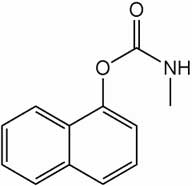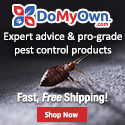Sevin (Carbaryl) Insecticide
-- An older, carbamate class
insecticide --
Summary: Carbaryl, the active ingredient in Sevin insecticide, belongs to one of the older chemical classes of insecticides called carbamates. As a group carbamates are only moderately toxic to mammals and are still widely used by gardeners. There are now, however, even lower toxicity alternatives for Sevin that gardeners can use.
Sevin (tm) Insecticide
Sevin is the trade name for a widely used synthetic insecticide containing the active ingredient carbaryl. Carbaryl belongs to the chemical class called carbamates. As insecticides go Sevin is only moderately toxic to mammals and is still widely used in gardens and landscapes. It is, however, highly toxic to honey bees and many other beneficial insects and mites.
Sevin is sold as a powder (Sevin dust), granule, and liquid concentrate. Uses include vegetable gardens, landscape plants, lawns, tree fruits and small fruits and the target pest list is broad and includes many common insect and mite pests.
While Sevin insecticide can be used safely there are now even safer alternatives that also avoid the harmful effects that broad spectrum chemicals, like carbaryl, can have on beneficial species.

Using Sevin Insecticide
Sevin is still used in gardens, lawns and lanscapes to control a wide variety of insect and related pests (see package instructions for a list of allowable applications). It is relatively inexpensive and widely available in granular, dust, and liquid formulations.
The granular formulation is typically used for lawn pests such as white grubs while the dust formulation is used in gardens and liquid formulations for landscape pest control. Dust formulations can be especially hazardous to pollinators like honey bees and Sevin Insecticide should not be used indoors, or on animals. The active ingredient in Sevin, carbaryl, is a potent neurotoxin.
"Softer" alternatives to Sevin
There are now low toxicity alternatives to Sevin and most other conventional insecticides that gardeners can use. Examples are insecticidal soap, horticultural oils, neem oil and the microbial insecticides. These materials are safer to apply, very effective and much less damaging to beneficial species than Sevin (see Natural and Biorational Pesticides for others).
You can use insecticidal soap on soft-bodied pests like aphids and spider mites, neem oil on pests that chew on leaves, horticultural oil on eggs and small larvae such as codling moth, and spinosad on a variety of pests, see Using Spinosad in Gardens for more information.
Supplies
Professional-level pest control supplies are generally not available in home and garden stores but can be found at DoMyOwn.com, our affiliate.

How to search 'Bugs for more information
The easiest way is to open a Google search page and type: "your query" + site:livingwithbugs.com into the search box. For example, to find all 'Bugs articles about carpenter ants type: carpenter ants + site:livingwithbugs.com in the search box.
The resulting list of pages may contain some Google advertising (marked with "Ad" next to the URL) as well relevant pages from 'Bugs. The ads do not originate with 'Bugs.
